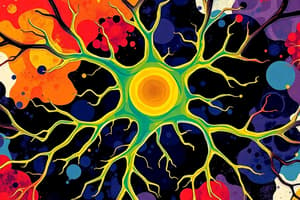Podcast
Questions and Answers
Q: Describe the structure and function of the neuron’s cell body, dendrites, and axon.
Q: Describe the structure and function of the neuron’s cell body, dendrites, and axon.
A: The cell body contains the nucleus and organelles (mitochondria, endoplasmic reticulum, ribosomes, Golgi apparatus) responsible for cell function.
Dendrites are short, branched extensions that carry impulses toward the cell body.
The axon is a long, single extension that carries impulses away from the cell body and ends in branches called axon terminals.
Q: Explain the structure and role of the myelin sheath and neurilemma in neurons.
Q: Explain the structure and role of the myelin sheath and neurilemma in neurons.
The myelin sheath is a fatty layer covering most axons, acting as an insulator, protecting the axon, and speeding up impulse transmission.
In the peripheral nervous system, Schwann cells form the myelin sheath and neurilemma (outermost coil), which aids in nerve fiber repair. In the central nervous system, oligodendrocytes produce the myelin sheath, with myelinated areas called white matter and unmyelinated areas called grey matter.
Q: Describe the function of synapses and neurotransmitters in neuron communication.
Q: Describe the function of synapses and neurotransmitters in neuron communication.
A: Synapses are junctions where the axon terminal of one neuron connects to the dendrite or cell body of another, separated by a small gap. Neurotransmitters are chemicals that carry impulses across this gap, enabling neuron-to-neuron communication. A similar synapse, called a neuromuscular junction, occurs between an axon and a muscle cell.
Q: Compare the functions of sensory, motor, and interneurons.
Q: Compare the functions of sensory, motor, and interneurons.
Q: Identify and describe the structural types of neurons: multipolar, bipolar, unipolar, and pseudounipolar.
Q: Identify and describe the structural types of neurons: multipolar, bipolar, unipolar, and pseudounipolar.
Q: What are nerve fibres, and how do they form a nerve?
Q: What are nerve fibres, and how do they form a nerve?
Q: What are the three main functions of the myelin sheath, and where is it formed in the peripheral and central nervous systems?
Q: What are the three main functions of the myelin sheath, and where is it formed in the peripheral and central nervous systems?
Q: Explain the difference between white matter and grey matter in the nervous system.
Q: Explain the difference between white matter and grey matter in the nervous system.
Q: How do neurotransmitters function at synapses and neuromuscular junctions?
Q: How do neurotransmitters function at synapses and neuromuscular junctions?
suggest why interneurons are multipolar in structure
suggest why interneurons are multipolar in structure
Flashcards are hidden until you start studying



